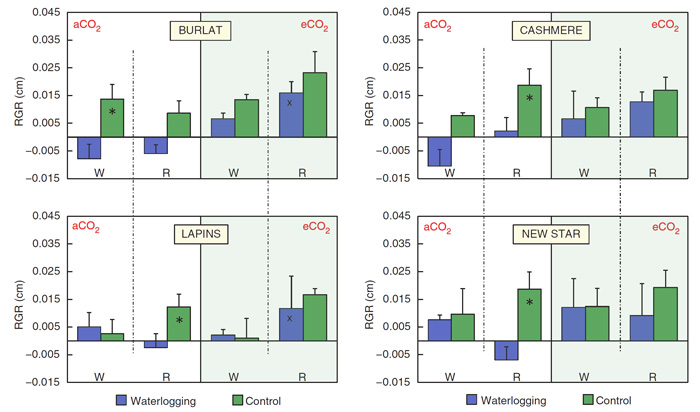| Tweet | Follow @co2science |
Paper Reviewed
Pérez-Jiménez, M., Hernández-Munuera, M., Zapata, M.C.P., López-Ortega, G. and del Amor, F.M. 2017. To minuses can make a plus: waterlogging and elevated CO2 interactions in sweet cherry (Prunus avium) cultivars. Climate Dynamics 44: 3469-3479.
Waterlogging is an abiotic stress caused by excessive rainfall events that cause flooding of a plant's root zone for extended periods of time. It negatively impacts plant photosynthesis and stomatal conductance; and it causes reduced oxygen concentration in soils. Consequently, waterlogging leads to a drastic drop in the level of oxygen in plant tissues and can cause a malfunction of nutrient uptake and allocation systems, resulting in deficiencies that threaten plant survival.
In contrast, it is well-known that elevated levels of atmospheric CO2 can reduce the impact of certain abiotic plant stresses. Hence, it was the objective of Pérez-Jiménez et al. (2017) to investigate the combined effects of elevated CO2 and waterlogging, to see if the positive impacts of higher levels of atmospheric CO2 could alleviate the negative impacts of this abiotic stress.
To accomplish their goal, the team of five Spanish researchers subjected four one-year-old sweet cherry (Prunus avium) cultivars (Burlat, Cashmere, Lapins and New Star) that were grafted onto P. cerasifera x P. munsoniana cv. Mariana 2624 rootstock to a seven-day waterlogging experiment in controlled-environment chambers under either ambient (400 ppm) or elevated (800 ppm) CO2 levels. Initially, the grafted plants were left in the growth chambers for a 7-day acclimation period, after which half of the plants were subjected to a waterlogging treatment (full submersion of the plant root zone to a height of 2 cm above the soil surface) for 7 days. Following the week-long waterlogging, the trees were removed from the water, drained and placed in the same conditions as the control plants for a 7-day recovery period.
The results of the experiment revealed that waterlogging decreased plant photosynthesis, stomatal conductance, transpiration, chlorophyll fluorescence and growth. In addition, it enhanced the accumulation of proline, chloride and sulfate. However, in the words of the authors, elevated CO2 "not only mitigated all these [negative] effects but also induced the accumulation of soluble sugars and starch in the leaf." In particular, as shown in Figure 1 below, plants in the elevated CO2 treatment did not exhibit a decline in growth during waterlogging stress. Consequently, Pérez-Jiménez et al. conclude that "waterlogging, like other abiotic stresses, can be overcome at elevated CO2."

Figure 1. Effects of waterlogging and elevated CO2 (eCO2, 800 ppm) on the relative growth rate (RGR) of the diameter of four sweet cherry cultivars (Burlat, Cashmere, Lapins and New Star) grafted on Mariana 2624 rootstock after waterlogging (W) and recovery (R) phases. Values are means ± SE. X denotes significant differences (P < 0.005) between plants of the same cultivar after the same phase in different CO2 treatments; * denotes significant differences (P < 0.005) between waterlogged and control plants for the same CO2 treatment, phase and cultivar. Source: Pérez-Jiménez et al. (2017).




